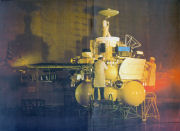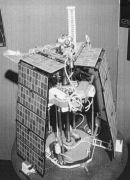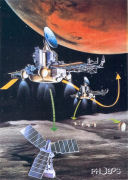








|
The
Phobos mission
In 1988, two space probes of identical construction, Phobos-1 and
Phobos-2, were launched from the Soviet Union towards the planet Mars.
As planetary missions, they were devoted to studying the planet Mars
and its vicinity, along with its natural satellite Phobos giving the
expedition its name, and also the Sun and the interplanetary
environment. At the time of the Phobos encounter, two small landers
should have been separated from them.
The Phobos-1 failed to get directed
towards the Mars but Phobos-2 managed to get close to it. Shortly
before the final phase of the mission during which the spacecraft was
to approach within 50 m of Phobos’ surface and release two landers (one
a mobile ‘hopper’, the other a stationary platform), the contact with
Phobos-2 was lost. The mission ended when the spacecraft signal failed
to be successfully reacquired on 27 March 1989. The cause of failure
was to be a malfunction of the orbiters's onboard computer.
Our human resource participated in
the development of the central computer of the stationary lander by the
leading of KFKI RMKI. It was planned to control all of the small
spacecraft’s scientific experiments (Longterm Autonomous Lander LAS -
Russian short name is DAS) and the service system (radio,
energy and thermal systems). The computer had a fault-tolerant
architecture: a single error would not cause degradation in operation
in operation; in the case of multiple errors some degradation could
arise: certain experiments would be terminated but the functionality of
the lander should be maintained. The central processor unit contained
two 8-bit microprocessors, three independent memory data flows were
united in majority logic. The circuit worked even if one of the
memories was not functional, and the majority logic circuits could be
switched over to multiplexers by commands and data could be read from
the selected memory unit. Another protection method was the use of two
alternative write-protected areas in the memory in which the basic
system status information was saved periodically. This protected system
information could have been used in case of failure when a processor
switch-over happens. In this system, the clock unit was four times
active (hot) reserved, and the other units of the system (interfaces)
had passive (cold) redundancy.
2 4. March 2015
|
 Phobos
s/c
integration Phobos
s/c
integration
in IKI

Longterm
Autonomous
Lander (DAS)

Planned
Landing on
Phobos surface
|


